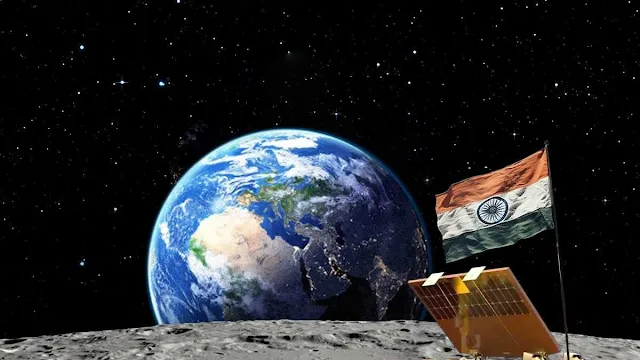India's Lunar Triumph: Chandrayaan-3 Sets Sail for Moon Success
 |
"India's Lunar Triumph: Chandrayaan-3 Sets Sail for Moon Success |
Exploring the celestial bodies beyond our planet has been a dream that humans have pursued for centuries. In this modern era of space exploration, India has emerged as a significant player with its Chandrayaan missions. After the successes of Chandrayaan-1 and Chandrayaan-2, the Indian Space Research Organisation (ISRO) set its sights on Chandrayaan-3, a mission designed to achieve a successful soft landing on the Moon. In this comprehensive guide, we will delve into the step-by-step journey of Chandrayaan-3, from its conceptualization to its triumphant landing on the lunar surface.
1. Mission Conceptualization and Design
The Chandrayaan-3 mission began with a meticulous conceptualization phase. Engineers and scientists at ISRO studied the lessons learned from the Chandrayaan-2 mission and identified areas for improvement. The goal was clear: to design a mission that would focus solely on the soft landing aspect, minimizing complexities and potential points of failure.
2. Payload and Instrumentation
The payload and instrumentation of Chandrayaan-3 were crafted to ensure precise and accurate data collection during its journey and landing on the Moon. The mission incorporated advanced cameras, sensors, and scientific instruments to study the lunar surface, its mineral composition, and the presence of water molecules.
3. Launch and Trans-Lunar Injection
The journey to the Moon commenced with the launch of Chandrayaan-3 aboard a powerful GSLV Mk III rocket. This phase required impeccable timing and calculations to execute the trans-lunar injection, a critical maneuver that set the spacecraft on its trajectory toward the Moon. The propulsion systems had to function flawlessly to ensure the spacecraft's accurate positioning.
4. Lunar Orbit Insertion and Pre-Landing Preparations
After a journey of several days, Chandrayaan-3 entered the Moon's gravitational sphere and performed a lunar orbit insertion. This phase demanded precision in firing the onboard engines to slow down the spacecraft and enable it to be captured by the Moon's gravity. Preparations for the soft landing began during this phase, as engineers meticulously reviewed the spacecraft's health and readiness for the descent.
5. Descent and Landing
The descent and landing phase of Chandrayaan-3 was the most critical and anticipated part of the mission. This phase involved a series of intricate steps to ensure a controlled and safe landing on the lunar surface. The spacecraft had to autonomously adjust its trajectory based on real-time data and navigate through potential hazards.
Powered Descent: The spacecraft initiated a powered descent using its propulsion system. The descent had to be carefully calculated to minimize the risk of crashing or deviating from the intended landing site.
Terrain Mapping and Hazard Avoidance: Advanced cameras and sensors provided real-time imagery and data of the landing site. The spacecraft analyzed this information and made split-second decisions to avoid any hazardous obstacles, such as boulders or craters.
Throttling and Final Approach: As Chandrayaan-3 neared the lunar surface, the propulsion system was precisely throttled to ensure a gentle descent. This phase required exceptional control to prevent a crash landing or a too-soft landing that could result in a lack of stability.
Touchdown: After a tense sequence of maneuvers, Chandrayaan-3 successfully touched down on the Moon's surface. The landing was a testament to the dedication, expertise, and innovation of the ISRO team.
6. Post-Landing Operations and Scientific Endeavors
Once Chandrayaan-3 safely landed on the Moon, its scientific operations commenced. The onboard instruments and sensors started collecting data about the lunar environment, surface composition, and any potential presence of water molecules. This data was transmitted back to Earth for analysis and interpretation by scientists and researchers.
7. Public Outreach and International Collaboration
Throughout the Chandrayaan-3 mission, ISRO maintained a strong focus on public outreach and international collaboration. The agency shared updates, images, and insights from the mission through various platforms, inspiring the younger generation and fostering an interest in space science and exploration. Additionally, Chandrayaan-3's success led to increased collaboration with other space agencies, enabling the exchange of knowledge and expertise.
8. Mission Evaluation and Future Prospects
Following the successful landing of Chandrayaan-3, ISRO conducted a comprehensive evaluation of the mission's achievements, challenges, and lessons learned. This analysis played a crucial role in shaping the future of India's space exploration endeavors, including potential follow-up missions and collaborations.
Conclusion
The journey of Chandrayaan-3 from conceptualization to its triumphant landing on the Moon's surface stands as a testament to human ingenuity, perseverance, and collaborative efforts. India's ambitious space program continues to inspire generations and contribute to the global advancement of space science. As we look to the future, the lessons learned from Chandrayaan-3 will undoubtedly pave the way for even more remarkable achievements in the realm of space exploration.
